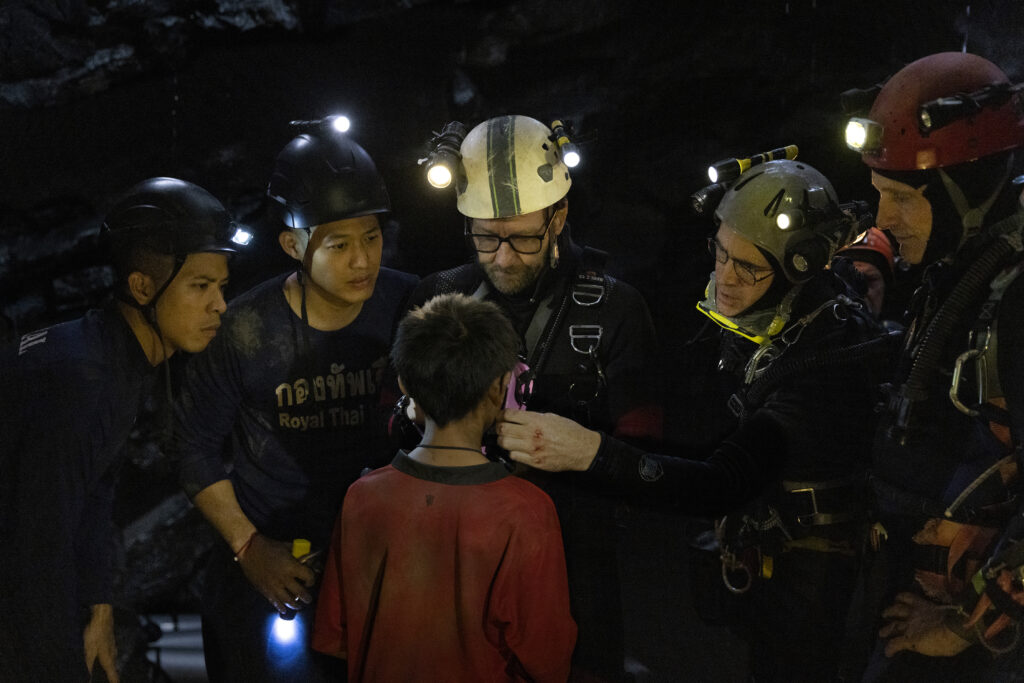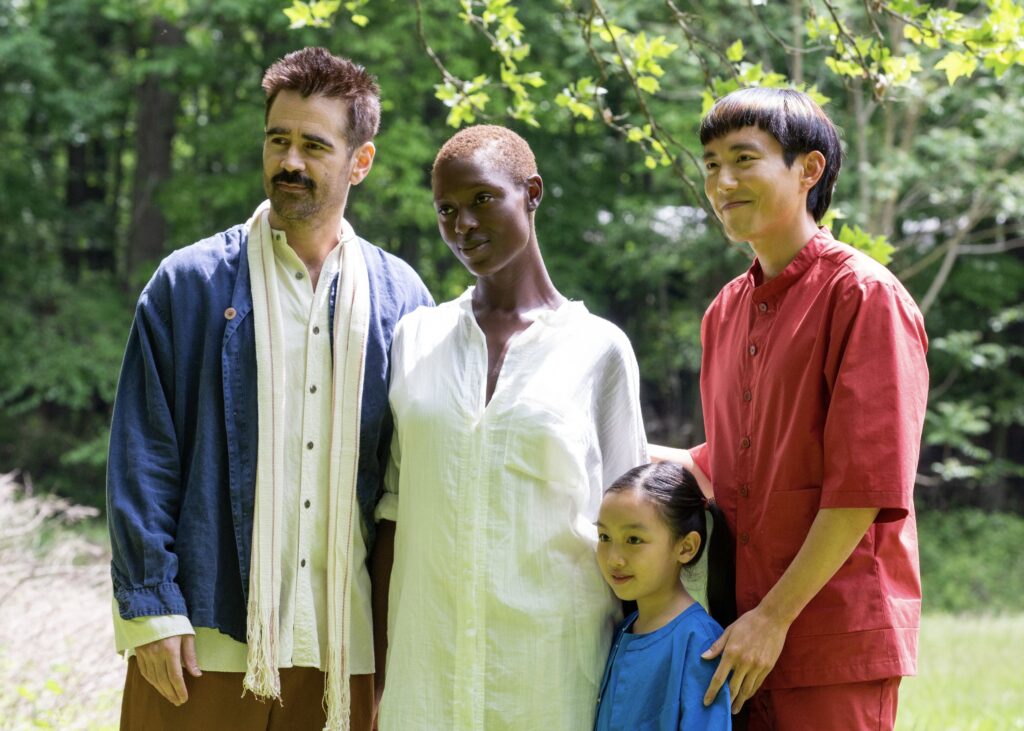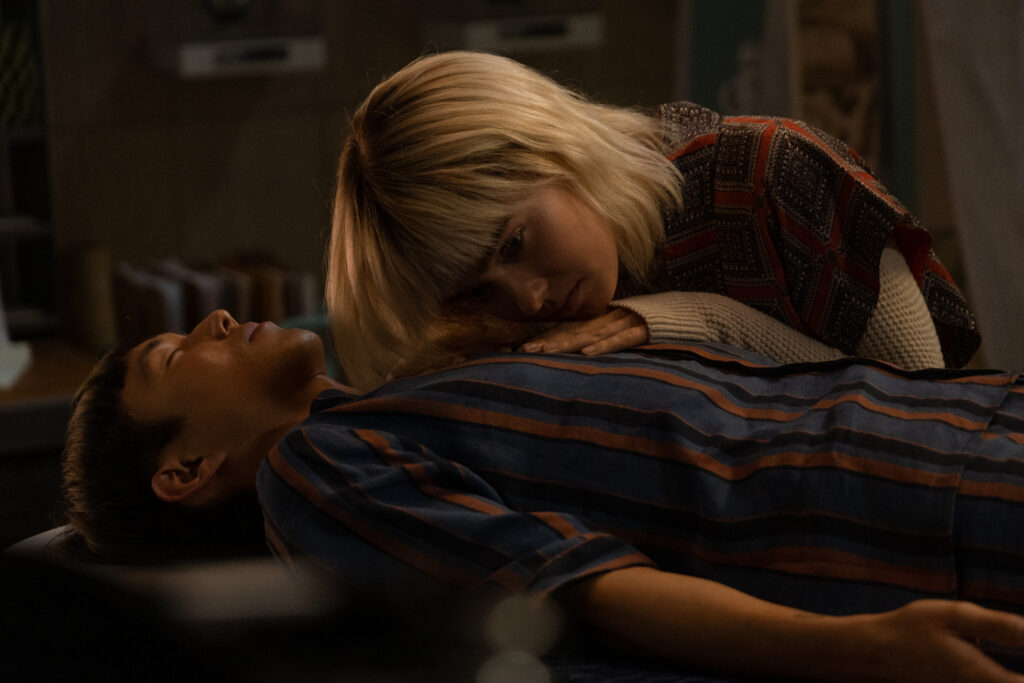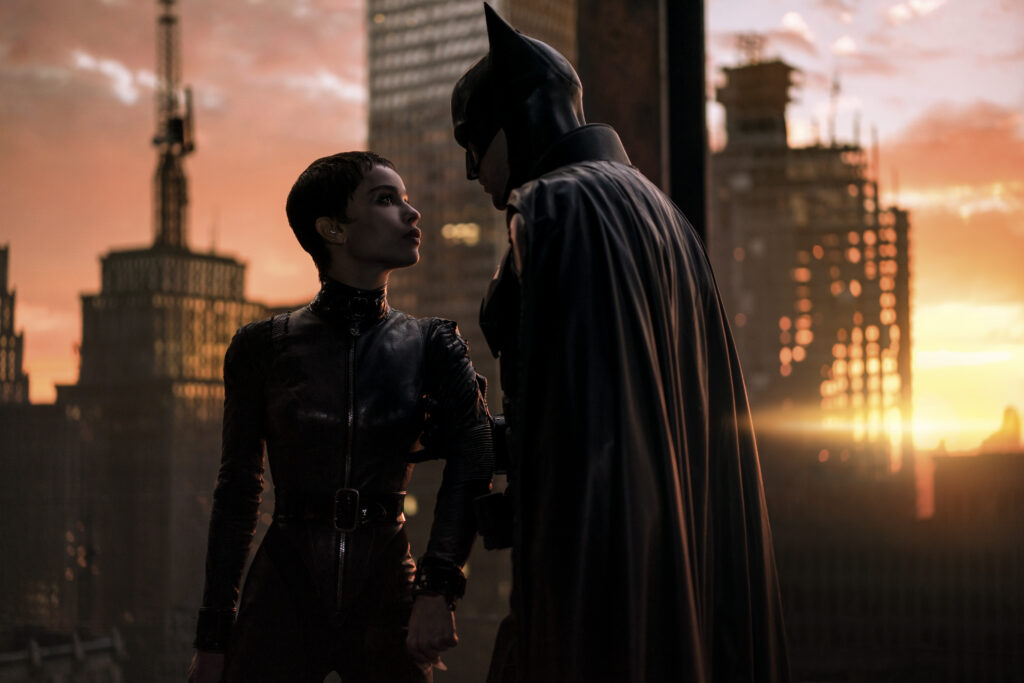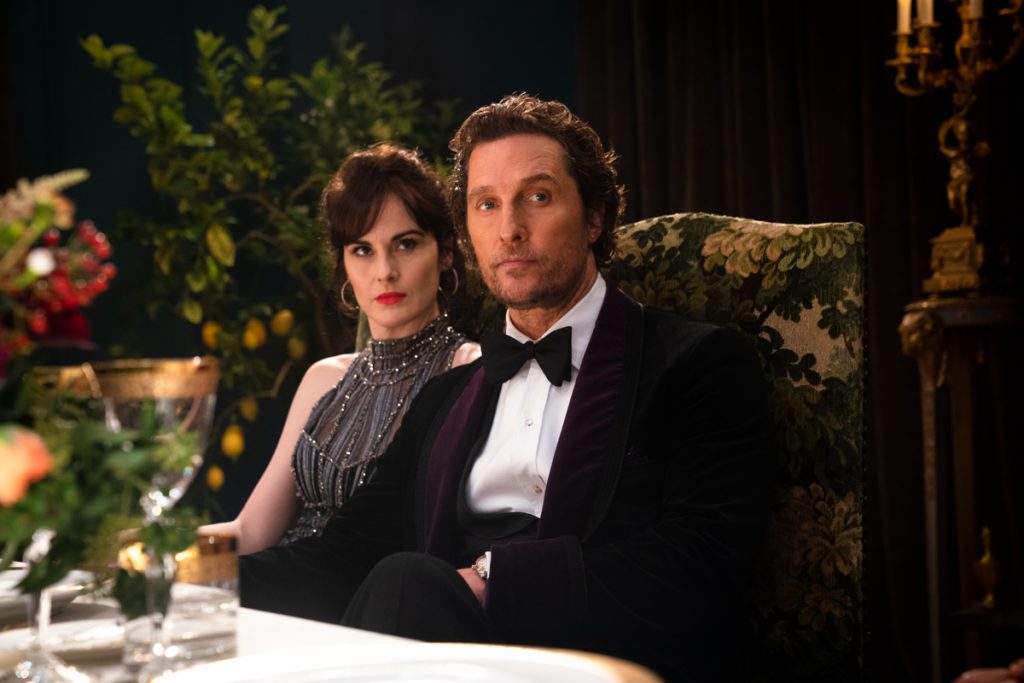October 21, 2022
by Carla Hay

Directed by Martin McDonagh
Culture Representation: Taking place in 1923, on the fictional Irish island of Inisherin, the comedy/drama film “The Banshees of Inisherin” features an all-white cast of characters representing the working-class.
Culture Clash: Two men who have been best friends—a farmer in his 40s and a musician in his 60s—have their emotional stability tested when the musician abruptly ends the friendship and goes to extreme lengths to get his former friend to stop communicating with him.
Culture Audience: “The Banshees of Inisherin” will appeal mainly to people who are fans of stars Colin Farrell and Brendan Gleeson; filmmaker Martin McDonagh; and movies that make darkly comedic and emotionally incisive commentaries about the highs and lows of human nature.
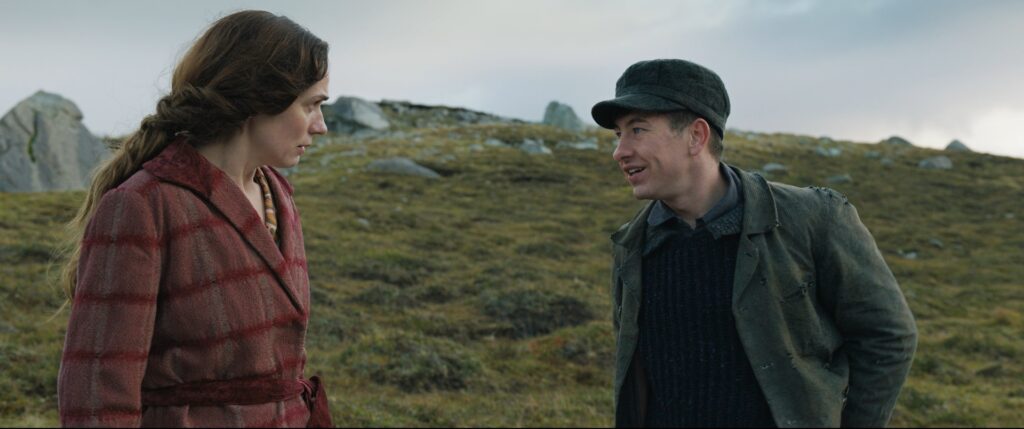
“The Banshees of Inisherin” offers a bittersweet exploration of the heartbreak, loneliness, hope, and bizarre unpredictability of life with two estranged friends in a rural Irish town. Colin Farrell and Brendan Gleeson give magnetic performances as two former friends who want very different things in existing together in this small, tight-knit and gossipy community. This comedy/drama movie reunites Farrell, Gleeson, and writer/director Martin McDonagh, who previously worked together on the 2008 assassin dramedy “In Bruges,” a very different movie from “The Banshees of Inisherin.”
McDonagh should be given a lot of credit for not wanting to copy “In Bruges” in this reteaming with the dynamic duo of Farrell and Gleeson, who played bickering hit men in the movie, which was set in Bruges, Belgium, in late 2000s. “In Bruges” had a madcap energy and some wacky plot developments that bordered on the absurd. “The Banshees of Inisherin” is often bleak, dreary and carries the emotional weight of characters wallowing in personal despair, but not having the words or resources to cope well with their personal problems. “The Banshees of Inisherin” had its world premiere at the 2022 Venice International Film Festival, where Farrell won the award for Best Actor, and McDonagh won the prize for Best Screenplay.
Set in 1925 on the fictional island of Inisherin (off of the coast of Ireland), “The Banshees of Inisherin” shows how the unraveling of a friendship spirals out of control into madness and tragedy. The movie is about more than some of the outlandish things that happen during the course of the story. It’s also about the mundanity of being stuck and stifled by a life of drudgery and limited options. It’s also about the need for people to feel loved and accepted by those whom they love and accept.
Viewers never get to see how the friendship developed between longtime Inisherin residents Pádraic Súilleabháin (played by Farrell) and Colm Doherty (played by Gleeson), because “The Banshees of Inisherin” begins on the day that Pádraic finds out that Colm not only wants to end the friendship, but Colm also wants Pádraic to stop communicating with him. Pádraic is a farmer in his 40s. Colm is a musician in his 60s. Both are bachelors with no children. Up until their estrangement, they were constant companions.
It’s unknown if Colm ever got married, but it’s made clear that Pádraic has never been married and is generally inexperienced and uninterested about a lot of things outside of Inisherin and his farm life. The movie doesn’t go into details about their sexualities or their love lives, but it’s implied that Colm and Pádraic have an older brother/younger brother type of relationship.
Somehow, their friendship became the center of their social lives. Colm lives alone, while Pádraic lives with his sister Siobhan Súilleabháin (played by Kerry Condon), who is a never-married bachelorette in her 40s with no children. Siobhan and Colm are the most important people in Pádraic’s life. Pádraic and Siobhan, whose parents died seven years earlier, are the only Súilleabháin family members who live on the island of Inisherin.
Pádraic and Colm each has a beloved pet that plays a pivotal role in the story. Padraic’s favorite animal on the farm is a miniature donkey named Jenny, whom he treats like a child. (Jenny has some adorable animal scenes in the movie.) Pádraic and Siobhan sometimes argue because Pádraic wants to let Jenny stay in their house, while Siobhan refuses and insists that Jenny stay in the area where the rest of the farm animals are kept. Colm’s only pet is his devoted male Border Collie named Sammy, who is Colm’s only constant companion in the story.
Pádraic is an uncomplicated person who places a high value on honesty and being nice to other people. He is the type of person who will say exactly what he’s thinking, even if it comes out in a way that might be awkward or not very tactful. Colm is much more complicated and someone who doesn’t always say what he’s thinking. Viewers will soon see that Colm has a dark side and how disturbed that dark side can be.
The unnamed rural town where Colm and Pádraic live has a very small population, so everyone in the community seems to know each other. (“The Banshees of Inisherin” was actually filmed in Inishmore and Achill Island in Ireland.) It’s the type of working-class town where no one can afford to have a car, so the usual form of vehicle transportation is a wheel cart.
The opening scene shows Pádraic walking to Colm’s house to meet him for their usual 2 p.m. visit to the local pub, which is called J.J. Devine Public House. Pádraic peeks in the front window and sees that Colm is sitting on a chair, smoking a cigarette, and looking lost in his thoughts. Pádraic taps on the window and calls out Colm’s name loud enough for Colm to hear, but Colm acts like he doesn’t hear anything and stares straight ahead.
Pádraic assumes that his friend will join him in the pub later, so he goes to the pub by himself. When Pádraic arrives, the pub’s owner/bartender Jonjo Devine (played by Pat Shortt) immediately asks Pádraic where Colm is, because Jonjo is so accustomed to seeing Pádraic and Colm together. “Are you rowing [arguing]?” Jonjo asks Pádraic, who says no. Pádraic tells Jonjo about Colm’s strange non-reaction when Pádraic went to visit him.
Colm is a no-show for their usual pub meet-up. A confused Pádraic goes home and tells Siobhan, who asks the same question: “Are you rowing?” Pádraic says no, and he’s not aware of anything that could’ve happened that would cause Colm to avoid him. Pádraic later goes back to the pub, where he sees Colm acting friendly and in good spirits with Jonjo and some of the customers.
When Colm sees Pádraic, the smile leaves Colm’s face, and Colm looks like he’s just seen someone whom he dislikes immensely. Pádraic, who is completely baffled, approaches Colm and asks him what’s going on and why Colm is acting this way. Pádraic also says that he’s sorry if he did anything to offend Colm. And that’s when Colm bluntly tells Pádraic that he doesn’t want to be Pádraic’s friend anymore because Colm thinks Pádraic is too dull and he’s become completely bored with their friendship. Colm also says that he doesn’t want Pádraic to talk to him anymore.
Colm, who is a fiddler, goes on to say that he’s getting old and wants to write great musical pieces before he dies. He cruelly tells Pádraic that Pádraic just drains time and energy from Colm, who wants to put that time and energy into writing music. Colm tells Pádraic that he’s “trying not to listen to the dull things you have to say.” Colm adds that he “has time not for aimless chatting but normal chatting.”
As an example of something that Pádraic does that Colm says is annoying, Colm mentions a recent conversation where Pádraic talked to Colm for two hours about the things he found in the feces of Pádraic’s donkey. Pádraic corrects Colm and said that the conversation about feces was actually about a pony, not a donkey. It’s an example of some of the dark comedy in this movie.
Pádraic is in shock and denial over this abrupt end to this friendship. The next day, he wakes up and sees on his calender that the day that Colm told him that their friendship was over also happened to be April Fool’s Day. Pádraic goes back to the pub and talks to Colm again, because he thinks that the conversation they had the night before was all a big April Fool’s Day joke. But to Pádraic’s dismay, Colm tells him in no uncertain terms that it’s not a joke.
And then, Colm makes this ominous threat: If Pádraic communicates with Colm again, Colm will cut off one of Colm’s own fingers every time it happens. It’s a threat that several people in the pub hear. And since this is a small town, word quickly spreads in the community about the alarming way that Colm wants to keep Pádraic out of Colm’s life.
Pádraic is naturally very distressed by this turn of events. He turns to Siobhan for emotional support, and she has to constantly deny it when Pádraic asks her if he’s dimwitted and dull. “You’re nice!” she finally yells in frustration. “Move on!” But Pádraic can’t move on. He’s still mystified over why Colm no longer wants to be his friend, and he wants them to be friends again.
Pádraic and Siobhan eventually come to the conclusion that Colm might be depressed. However, Pádraic being Pádraic, his nature is to want to be the one to help lift Colm out of Colm’s apparent depression. And the only way Pádraic knows how to do that is to talk to Colm.
While Pádraic is still reeling from being rejected by his best friend, a local guy in his 20s named Dominic Kearney (played by Barry Keoghan) has been tagging along with Pádraic very chance that he can get. Dominic, who appears to have learning disabilities, is a social outcast in this community. Padraic is the person in the community who is the kindest to Dominic. Just like Pádraic looks up to Colm like an older brother, Dominic seems to have a similar admiration for Pádraic.
Dominic also wants to spend a lot of time with Pádraic because Dominic comes from a very abusive home. It’s revealed fairly early on in the movie that Dominic’s widowed, alcoholic father Peadar Kearney (played by Gary Lydon) physically and emotionally abuses Dominic. The abuse goes beyond beatings and includes sexual abuse.
Peader happens to be the only police officer that this very small town has, so he gets away with these crimes. Peader also dislikes Pádraic and Siobhan, for past reasons that aren’t fully explained. However, it probably has a lot to do with the fact that Pádraic knows all about the abuse, and Dominic seems to want to be a part of the Súilleabháin more than Dominic wants to be part of his own family. The animosity between Peader and Pádraic increases when Peader and Colm start to become friendlier with each other after Colm ends his friendship with Pádraic.
Meanwhile, Dominic has a crush on Siobhan, but because he’s socially awkward, he doesn’t quite know how to express his feelings. Pádraic is too absorbed with trying to mend his friendship with Colm, so Pádraic doesn’t notice the significance of why Dominic asks him about Siobhan’s dating history and what kind of men Siobhan tends to like. Pádraic isn’t very helpful and gives vague answers. Just like her brother, Siobhan doesn’t have an active love life.
One evening, Dominic is invited over for dinner at Pádraic and Siobhan’s home. When Dominic asks Siobhan why she’s never been married, she gets angry and offended and tells him that it’s none of his business. She’s so insulted by this question, Siobhan tells Dominic to leave. Siobhan also doesn’t pick up on Dominic’s infatuation with her, so she doesn’t understand that Dominic asked that question as a way to flirt with her.
Some other characters in the movie have supporting roles as people who know a lot of the personal business of the people in this community. Mrs. McCormick (played by Sheila Flitton), an elderly woman who is an occasional visitor to the Súilleabháin home, looks and acts like someone who knows a lot of community secrets. Mrs. Reardon (played by Bríd Ní Neachtain), a middle-aged woman who runs the local convenience store/post office, is a very nosy gossip and doesn’t hestitate to open other people’s mail, in order to snoop. And then there’s the obligatory Catholic priest (played by David Pearse), a man in his late 20s or early 30s, who doesn’t have a name in the movie, but he hears people’s confessions.
The personal turmoil between Pádraic and Colm escalates when Pádraic just can’t accept that Colm wants Pádraic to leave Colm alone. Pádraic’s desperation is also affected when Siobhan gets a job offer to work at a library on the mainland of Ireland. The movie shows whether or not she takes that offer. It’s also shown if Colm follows through on his threat to cut off any of his own fingers after Pádraic continues to contact Colm.
“The Banshees of Inisherin” is not a big, flashy movie with elaborate scenes of drama. It’s a movie that authentically shows the quiet desperation that people feel but they suppress, in order not to be labeled as unstable, troublemakers or whiners. Pádraic shows a lot of emotional vulnerability that makes some members of the community more uncomfortable than Colm’s declaration of violent self-harm. It’s the movie’s way of showing how unnecessary violence is often more accepted in society as a way to cope with problems, rather than expressing emotional vulnerability.
Of course, in a movie about former friends who end up feuding with each other, there are some showdown scenes that are among the best in the movie. However, there are scenes where Pádraic or Colm is alone in a room, and those scenes are just as powerful. Farrell and Gleason handle their respective characters with a level of authenticity that resonates, even when some unhinged things start to happen. Condon and Keoghan are also quite good in their roles, although the characters of Siobhan and Dominic are ultimately overshadowed by what goes on between Pádraic and Colm.
McDonagh’s movies and plays often show human nature at its worst and its best. His movies and plays also depict aspects of life that can be depressing or joyful. It’s a dichotomous balance that isn’t easy to achieve, but McDonagh’s sharp talent in writing and directing, as well as his ability to make great decisions with a top-notch cast, result in “The Banshees of Inisherin” being a sometimes uncomfortable but definitely a memorable and emotionally moving ride.
Searchlight Pictures released “The Banshees of Inisherin” in select U.S. cinemas on October 21, 2022. The movie will be released on digital and VOD on December 13, 2022, and on Blu-ray and DVD on December 20, 2022.

